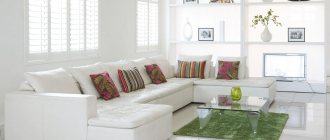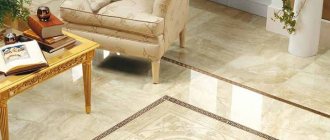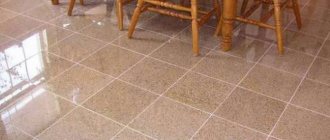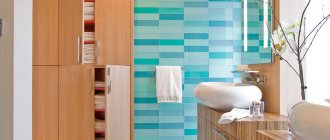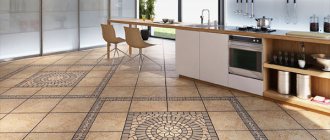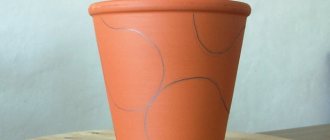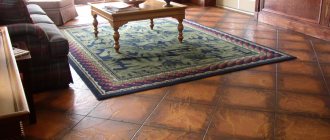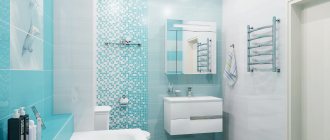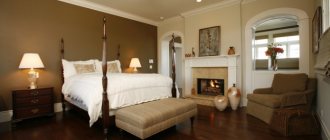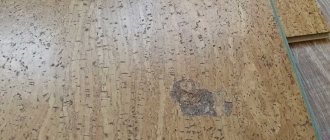Every year at least a dozen new varieties of finishing materials appear on the finishing materials market. Some of them are successfully replacing the old ones with better technical characteristics and performance indicators.
But this is not always the case. For example, Mettlach tiles appeared more than a century ago in the German city of Mettlach (hence its name) and still remains one of the most popular types of tiles.
It was made from multi-colored porcelain and was used mainly in the decoration of palaces, for which it received its second name - “Victorian”.
Metlakh tiles - manufacturing features
Refractory clay is used as a raw material for tiles. In Russia, the main place of its production is the Dmitrovsky quarry. The main factories producing the product are located in its district.
Tiles of different shapes and sizes are formed from this clay, then glaze is applied to it and sent to ovens, where they are baked at a temperature range from 1100 to 1300 degrees.
Due to the powerful compaction, the resulting product becomes wear-resistant and can withstand a large number of freezing cycles, which allows its installation not only in residential premises, but also in various administrative and public buildings.
Manufacturing technology
Metlakh tiles are used as a finishing material in private homes and public places. The technology for making tiles was invented back in the century before last in Europe. In terms of its performance qualities, the tile is close to durable porcelain stoneware, but unlike it, it can boast a variety of shapes, patterns and colors. That is why metlakh tiles make floors of the rarest beauty that remain unchanged for decades.
Interesting: the tile got its name in honor of the city of Mettlach (Germany). In the middle of the century, it was there that large-scale production of ceramic products was established. Over time, these German tiles became almost synonymous with the Victorian English style of architecture. In France today there is one of the few classical productions that has survived to this day.
The main component of Metlakh tiles is a special high-strength clay. It is covered with a thick layer of glaze and fired in an oven at temperatures above 1200C. As a result, the clay and glaze are sintered so tightly that the tiles acquire incredible durability and wear resistance. Thanks to these qualities, as well as resistance to chemicals, tiles can be used not only in residential premises, but even in industries and outdoors.
A wide variety of shapes and colors allows you to use Metlakh tiles to create original floor coverings and decorative cladding not only for walls, but even for furniture. The peak of the material's popularity came in the industrial era, when it became the personification of the Victorian architectural style. During the reign of Queen Victoria of England, Metlakh tiles decorated not only private properties, but also all palaces, factories, parks and other public places.
Today, despite technological progress, practically no innovations have been introduced into the production technology of Metlakh tiles, with the exception of expanding the color palette and increasing the variety of patterns. In other words, the tiles have only become better and richer, retaining all their advantages and practically losing their disadvantages.
Moreover, dedicated craftsmen are trying to restore the previous recipes of natural dyes and create samples of tiles identical to those used in the time of Queen Victoria. That is why Metlakh tiles are often used for the restoration of ancient buildings.
Technical parameters and advantages
Those who already know what metlakh tiles are in use note their high strength, color fastness, and ease of maintenance.
Even heavy objects installed on its surface and regularly moved do not cause cracks or scratches on the material. Many experts recommend it for use in those places where significant operating load is regularly practiced.
Also, the material is practically non-porous, so Metlakh floor tiles are used not only for tiling indoors, but also outdoors. The same quality makes it possible to install it in rooms with strict hygiene requirements.
If we talk in more detail about its technical coefficients, the following parameters should be highlighted:
- On the Mohs coating hardness scale - 7 out of 10 possible for tiles;
- Hydrophobicity from 0.1 to 0.5%;
- The bending strength is also high - 250 kgf/sq.m. cm;
- Water absorption is 0.1-0.5%. These indicators allow installation even in places with extremely high humidity and temperature fluctuations - in swimming pools, baths, saunas;
- Thermal stability meets existing standards - this is the ability of a tile to withstand a certain stress during dimensional deformation as a result of a sharp change in the temperature range;
- Resistance to deep scratches - 2.4 cm;
- Pressure endurance - 3200-5550 kg/cm2;
- Frost resistance - 150 cycles at temperatures from −15 to +25 according to research results. Lower temperatures have not been formally tested in laboratory tests;
- Acid resistance is higher than standard values - 97.71;
- Compressive strength - 90.8 MPa kg/cm2;
- High void wear resistance;
- Coloring elements penetrate almost the entire depth of porcelain tiles, which suggests high resistance to UV rays.
All these technical indicators have been tested in practical application. For example, Metlakh ceramic tiles are perfectly preserved in the historical interiors of ancient buildings in the capital and St. Petersburg, in palace premises of the Victorian era, hundred-year-old plants and factories.
Characteristics of Metlakh tiles
Despite a certain oblivion, Metlakh tiles are famous and are still in high demand in some circles. Of course, this would not have happened if this ceramic did not have excellent technical characteristics. Indeed, “metlah” is in many ways similar to ceramic granite, which has earned popularity due to its performance qualities. Below you can familiarize yourself with the advantages of good old ceramics from one of the companies in an organized format.
- Water absorption – 0.1-0.5%. Despite the fact that European standards allow for such tiles a coefficient of up to 0.6%.
- Hardness. The parameter is determined on a ten-point Mohs scale. “Metlah” takes seventh position (and, again, the norm is 6). Note that the highest hardness is given to the tenth line, and we are talking about assessing materials in general, and not strictly ceramics. By the way, there is a diamond at the very top, so seventh place is impressive.
- Frost resistance. The tiles can withstand up to fifty cycles of transition from sub-zero to positive temperatures (-15 – +20). This indicator corresponds to European standards. Such a high figure was made possible due to the density of the tiles and its, as a consequence, low water absorption.
- Chemical resistance. According to the standards, the reaction with active substances should not cause a change in the weight of the product by more than 1%. In the case of Metlakh tiles, we observe weight fluctuations within 0.2%.
- Flexural strength. Standards require the ability to withstand loads of up to 250 kgf per cm². The plates can withstand from 380 to 450 kgf per cm².
- Pressure resistance. The norm is more than 1500 kgf per cm². Fact – 3200 to 5500 kgf per cm².
In addition, or rather, precisely thanks to the described characteristics, Metlakh tiles are a heat-resistant material that is resistant to potholes and scratches. Let us remember the homogeneity of the product - this quality determines its immunity to abrasion. Crowds of human feet are not able to wear ceramics down to a state of unusability over a reasonable period of use.
It is curious that the Metlakh tiles, which were laid in churches in the Middle Ages (and then, mainly, religious institutions were decorated with ceramics of this type) in many places have still retained acceptable quality. True, the “brooms”, which were produced in the 19th century, no longer had such parameters - the production technology was deliberately simplified (and the tiles, accordingly, became cheaper), and along with this came a decrease in the properties of the ceramics. But even so, the tiles were able to last for many decades. Modern tiles are not inferior to their predecessors.
Metlakh tiles owe their impressive characteristics to the high-quality refractory clays from which they are produced and the high firing temperature (about 1200 degrees). Summarizing the properties of the slabs, we note that for the consumer they result in the opportunity to use the facing material for both internal and external cladding, both for laying on walls and for decorating floors. Most often, Metlakh tiles are used as flooring.
The sizes of the slabs vary from 3 to 20 cm. In this range you can find a variety of formats and shades, allowing you to create intricate compositional illustrations. The range of Metlakh tiles includes not only banal rectangular ceramics, but also polygons. All this serves a wealth of possibilities for laying colorful ornamental “carpets”. These “brooms” conquered many generations. To design non-standard places, there are additional elements: corners, sides, baseboards...
Step-by-step installation
Metlakh floor tiles are no more difficult to install than regular ones, except for the fact that even in one pack, the products may differ slightly in size from each other. It also freely allows you to combine prints, shapes and sizes, thereby achieving the effect of an incredibly beautiful, exotic tiled carpet.
Stage 1 - Preparing the base
It is very important to prepare the surface thoroughly, since you have chosen such an expensive type of tile, it must lie perfectly. Therefore, the surface must be carefully leveled, excluding differences, cleaned and primed.
Stage 2 - Layout
At this stage, you need to lay out the tiles on the floor from the central point of the plane, and also, if the pattern is complex and was selected independently, create a preliminary drawing of the arrangement of the elements.
Please note that the seam gap to achieve the greatest effect should be no more than 2 mm. These steps will allow you not to spoil the specified floor print and simplify the work of creating a specific layout.
Stage 3 - Installation
Next, you can dilute the glue in a clean container using a mixer. To apply it to tiles or floors (depending on how you lay it), use a notched trowel-comb with teeth from 3 to 6 mm.
Laying begins with large elements if different-sized products are used.
Adjustment of the thickness gauge occurs by increasing or decreasing the adhesive layer.
Do not forget to regularly check the evenness of the coating with a level.
Stage 4 - Curbs
Borders are laid from the corner to the center. If trimming is required, this must be done with a special machine and a disc for cutting porcelain stoneware.
Stage 5 - Grouting
If you are laying out a colorful carpet, the grout for the seams should be plain and dim.
First, clean the joints from dust and degrease them. Then use a brush or spray to wet the seams.
The mastic is applied with a rubber spatula, compacting it into the surface so that there are no gaps left.
When the grout is dry, moisten it lightly with water to prevent cracking.
Laying metlakh tiles
Surface preparation
First of all, the surface of the base is carefully leveled. If the tiles are not laid indoors, it is necessary to treat the base with a substance to protect against frost. It is also important to clear the base of all debris, sweep and wash so that the tiles lie flat and do not wobble.
After this, the surface is carefully measured, taking into account all the bends of the walls, doorways, pipes, radiators, etc. Based on these measurements, the central point of the room is found, from which guide lines are drawn in all directions. These lines can either be drawn on the floor or formed from stretched threads.
Features of the production of Metlakh tiles
The modern manufacturing process is different from what it was originally. Today, Metlakh floor tiles are made from clay, which has good refractoriness. It is fired at high temperatures.
As a result, the porcelain is tightly sintered, so the finished product becomes resistant to various negative influences:
- temperature changes;
- chemicals, including aggressive ones;
- humidity.
There are very few factories producing such tiles left in the world. Most of them have been preserved since the 19th century. They are the ones who create unique high-quality Metlakh ceramic tiles. After all, production technology has not changed until now. These factories are located in Russia, Portugal and France.
Metlakh tiles are an opportunity to create unusual compositions. Photos of finished interiors confirm this. And the scope of its application is incredibly broad.
